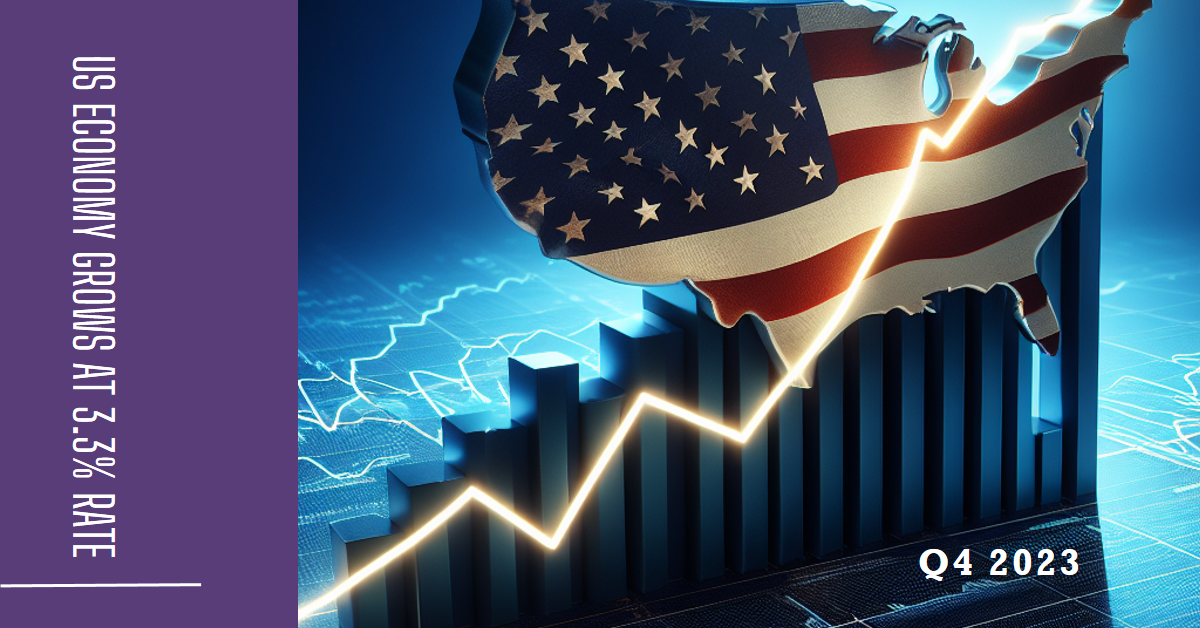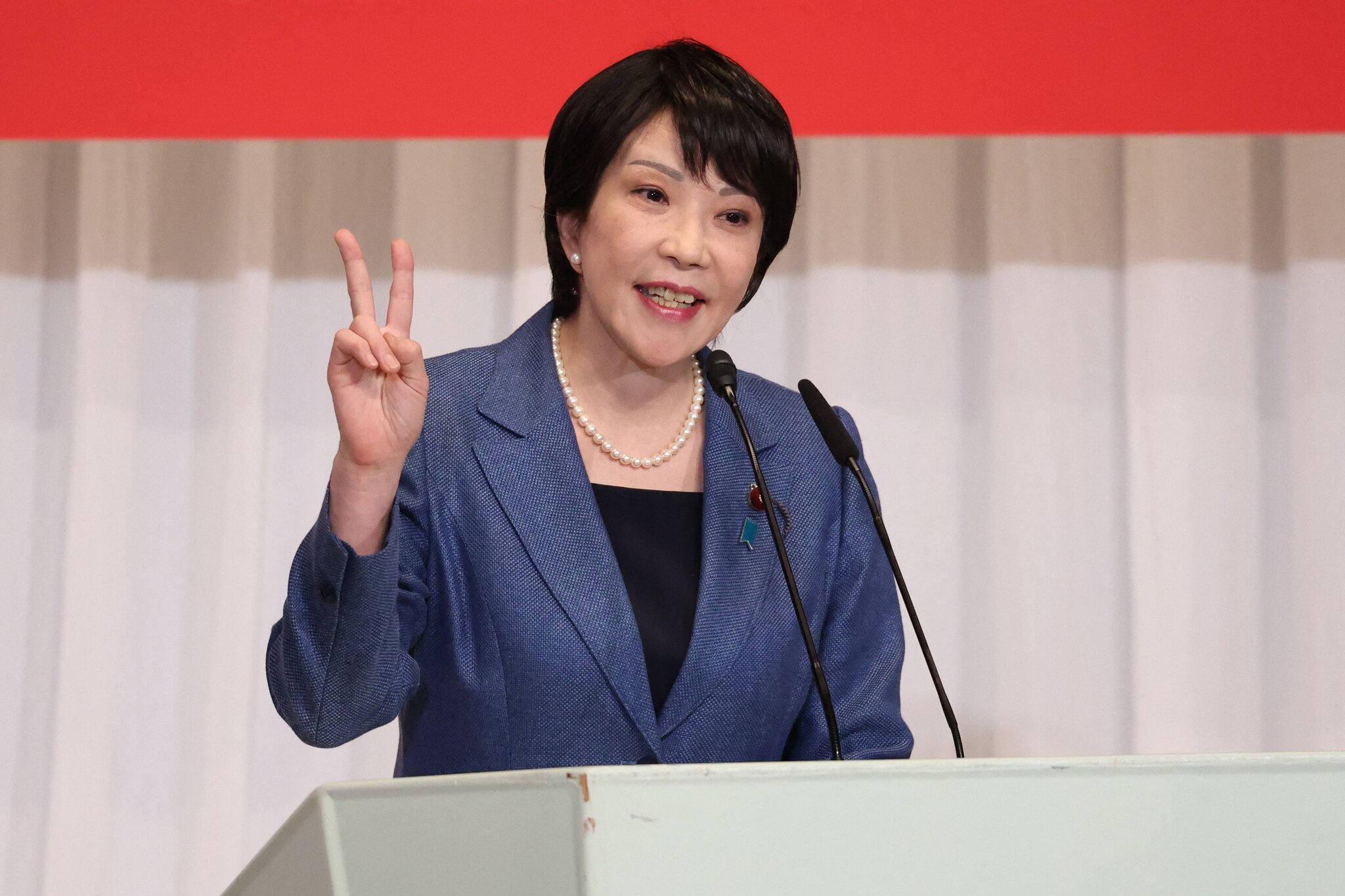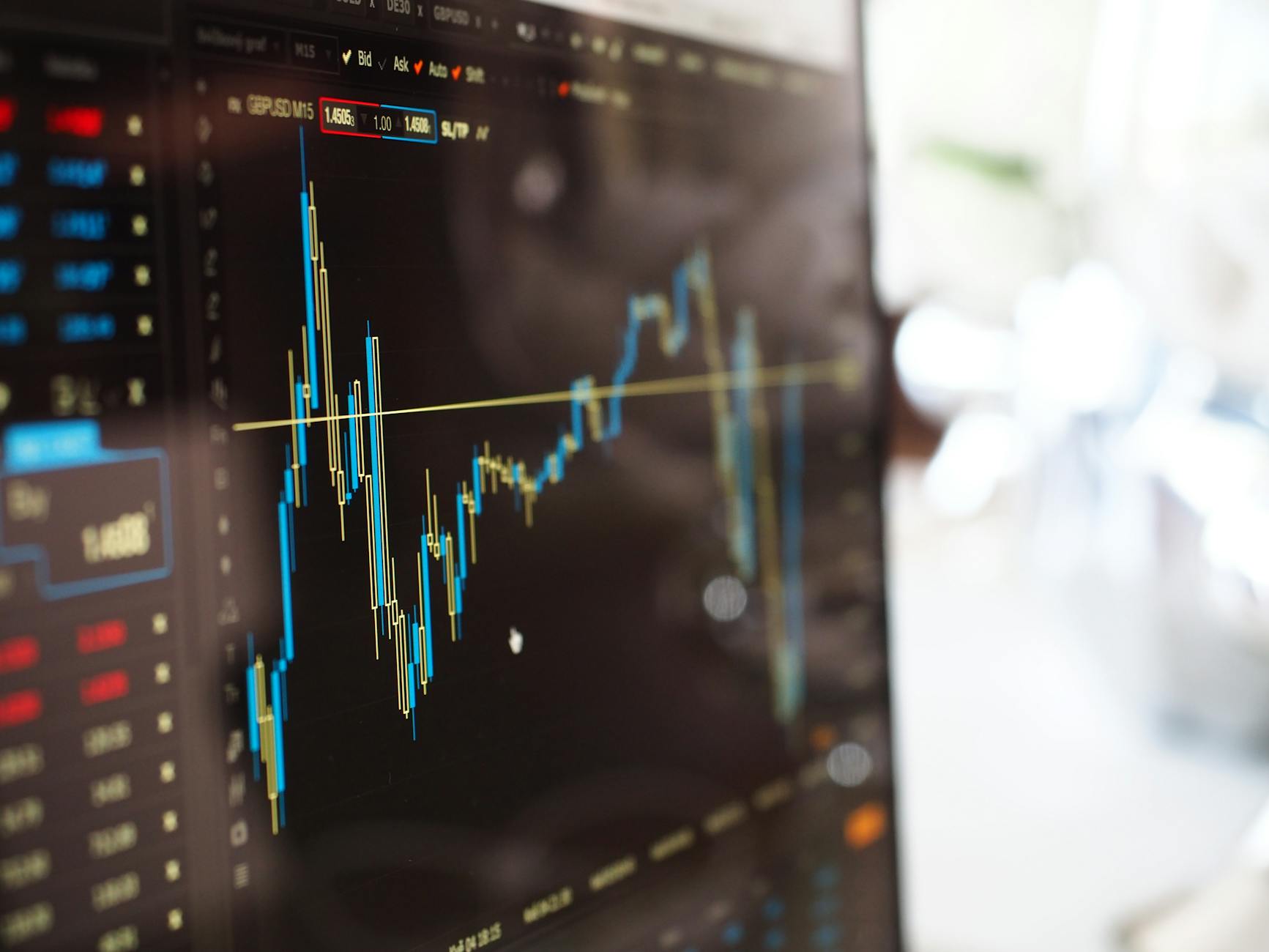Economy
US Economy Grew at 3.3% Rate in Q4 2023, Beating Wall Street Estimates

The US economy grew at a blistering pace of 3.3% in the fourth quarter of 2023, according to the Bureau of Economic Analysis. This growth rate was much higher than the Wall Street consensus estimate of 2%1. The economy’s growth rate for the entire year of 2023 was 2.5%, which was better than the 1.9% increase in 2022 and ahead of the Wall Street outlook at the beginning of the year for few if any gains1. The strong pace of consumer spending and government spending helped drive the expansion1.
Table of Contents
Introduction
The US economy has been on a rollercoaster ride since the pandemic hit the world. The economy has been through a lot of ups and downs, but it seems like it is finally on the path to recovery. The latest data shows that the US economy grew at a blistering pace of 3.3% in the fourth quarter of 2023. This growth rate was much higher than the Wall Street consensus estimate of 2%. In this article, we will discuss the reasons behind this growth and what it means for the future of the US economy.

Consumer Spending
One of the main reasons behind the growth of the US economy is the strong pace of consumer spending. Personal consumption expenditures increased by 2.8% for the quarter, down just slightly from the previous period. People bought new cars, spent on recreation, and took trips. This shows that people are confident about the future of the economy and are willing to spend money. This is a good sign for the future of the US economy as consumer spending is a major driver of economic growth.
Government Spending
Another factor that contributed to the growth of the US economy is government spending. State and local government spending increased by 3.7%, and federal government expenditures increased by 2.5%1. This shows that the government is investing in the economy and is willing to spend money to boost economic growth. This is a good sign for the future of the US economy as government spending can help create jobs and stimulate economic growth.
Inflation
There was progress on inflation in the fourth quarter of 2023. Core prices for personal consumption expenditures rose by 2% for the period, while the headline rate was 1.7%1. This is good news for the US economy as inflation can be a major hindrance to economic growth. The Federal Reserve prefers core prices for personal consumption expenditures as a longer-term inflation measure. On an annual basis, the PCE price index rose by 2.7%, down from 5.9% a year ago. This shows that inflation is under control and is not a major concern for the US economy.
Conclusion
The US economy grew at a blistering pace of 3.3% in the fourth quarter of 2023. This growth rate was much higher than the Wall Street consensus estimate of 2%. The strong pace of consumer spending and government spending helped drive the expansion. Inflation is under control, which is good news for the US economy. The future of the US economy looks bright, and we can expect to see more growth in the coming years.
Discover more from The Monitor
Subscribe to get the latest posts sent to your email.
Analysis
Pennsylvania’s Economy at a Crossroads: Why Local Signals from WNEP Matter Nationally

Our Editorial Chief and senior columnist’s opinion on how regional shifts in PA reflect the broader U.S. economy.
Table of Contents
Introduction
The U.S. economy is often measured in sweeping national statistics—GDP growth, inflation rates, and interest‑rate decisions. Yet the real pulse of America’s financial health beats in its local communities. Pennsylvania, with its diverse industries and working‑class backbone, offers a telling microcosm of national trends. And through outlets like WNEP, local anxieties and aspirations are broadcast daily, shaping how residents—and by extension, the nation—interpret the state of the economy.
Macro Context: The National Economy Meets Local Reality
At the national level, policymakers are grappling with inflationary pressures, uneven job growth, and questions about consumer confidence. Wall Street analysts debate whether the U.S. economy is heading for a soft landing or a prolonged slowdown. But in Pennsylvania (PA), these abstract debates translate into tangible realities: factory shifts, small business closures, and household budgets stretched thin.
Pennsylvania’s economy has long been a bellwether. Its manufacturing hubs, energy corridors, and healthcare networks mirror the broader U.S. industrial mix. When the state’s job market tightens or consumer spending dips, it often foreshadows national patterns.
“Local economies are the real pulse of national health. Ignoring signals from places like Pennsylvania risks misreading the bigger picture.”
Regional Insights: WNEP and the Pennsylvania Lens
Local news outlets like WNEP play a critical role in contextualising these shifts. Coverage of rising grocery prices, layoffs in regional plants, or new infrastructure projects provides a ground‑level view of the economy that national headlines often miss.
- Manufacturing: Once the backbone of PA’s economy, it now faces global competition and automation challenges.
- Healthcare: A growing sector, yet burdened by staffing shortages and rising costs.
- Logistics & Energy: Pennsylvania’s geographic position makes it a hub for distribution and energy production, sectors that are sensitive to national policy shifts.
By reporting on these industries, WNEP not only informs residents but also contributes to the national narrative.
Business & Consumer Implications
For small businesses in PA, the economy is not an abstract concept—it’s survival. Rising interest rates make borrowing harder, while inflation erodes margins. Consumers, meanwhile, adjust by cutting discretionary spending, delaying home purchases, or seeking additional income streams.
This dynamic reflects a broader truth: the health of the U.S. economy is inextricably linked to the resilience of its local communities. Pennsylvania’s struggles and successes are America’s struggles and successes.
Opinion: The Columnist’s Perspective
As a senior columnist, I argue that local economies are the real pulse of national health. Wall Street optimism often overlooks Main Street realities. Ignoring signals from places like Pennsylvania risks misreading the bigger picture.
Consider this: while national GDP may show growth, if households in Scranton or Harrisburg are tightening belts, the sustainability of that growth is questionable. WNEP’s coverage of local hardships—job losses, rising costs, community resilience—offers insights that policymakers and investors cannot afford to ignore.
The contrarian view here is simple: the economy’s future may be written in Pennsylvania.
Conclusion
Pennsylvania’s economy is not just regional—it is predictive. From manufacturing floors to local newsrooms, the signals emanating from PA offer a window into America’s trajectory. Policymakers, investors, and readers alike must pay attention to these local cues.
As WNEP continues to spotlight the lived realities of Pennsylvanians, the rest of the nation would do well to listen.
Discover more from The Monitor
Subscribe to get the latest posts sent to your email.
Biography
The Steel and Silk: Why Sanae Takaichi is the LDP’s Only True Challenger to the Status Quo

The election of Sanae Takaichi as Japan’s first female prime minister is often framed as a symbolic gender breakthrough. That is a distraction. The real story isn’t her gender; it is her unapologetic, hardline conservative ideology that marks her as the single greatest threat to the LDP’s decades-long pattern of cautious, incremental change. As a protégé of the late Shinzo Abe, Takaichi is not merely maintaining his legacy; she is positioned to accelerate it, using a political momentum that few outside the core conservative base truly appreciate.
Her rise signals a defiant pivot toward a deeply nationalistic, robustly defended, and economically secure Japan—a vision that, if fully executed, would fundamentally reshape domestic policy and regional diplomacy.
Table of Contents
The “Three Pillars” of Takaichi’s Policy: Assertion, Security, and Pragmatism
Unlike her more moderate predecessors, Sanae Takaichi operates from a platform built on three distinct, high-impact policy pillars that resonate powerfully with the party’s core conservative and nationalist wing.
1. The Revived “Sanae-nomics” and Economic Security
Takaichi is a staunch advocate for aggressive public spending and monetary easing, echoing Abe’s economic formula. But her unique addition is the heavy focus on economic security. Having served as the first Minister of Economic Security, she prioritises strengthening domestic supply chains (especially in semiconductors and critical minerals), protecting technology from foreign leakage, and establishing measures to counter techno-economic risks. This is not just about growth; it’s about national resilience. She sees government spending as a strategic tool for “crisis-management investment”, challenging the traditional conservative aversion to large debt.
2. Accelerated Defense and Constitutional Reform
The core of her political identity is an assertive defence posture. Sanae Takaichi has wasted no time in signaling an acceleration of plans to bring defence spending to 2% of GDP, far ahead of previous targets. This is paired with an intent to revise the three core security documents (National Security Strategy, etc.) and a desire to formally establish Japan’s Self-Defence Forces as a national military by revising the pacifist Article 9 of the Constitution. The departure of the restraining influence of the Komeito party from the coalition has cleared the path for a much more proactive foreign and security policy, aligning perfectly with the hawkish stance of the Japan Innovation Party (Ishin), her new coalition partner.
3. Cultural and Social Conservatism
On social matters, Takaichi maintains a firm traditionalist line. She has consistently opposed reforms such as allowing married couples to use separate surnames and is against same-sex marriage. She has also taken a hard-line stance on immigration, calling for tighter visa regulations and a crackdown on illegal migrants. While criticised by liberals, this position strongly appeals to conservative voters who felt abandoned by the LDP in recent elections, aligning with a global trend of cultural conservatism.
The Media Narrative vs. The Ground Truth
Internationally, Sanae Takaichi is often reduced to a simple caricature: a “China hawk” and a historical revisionist due to her regular visits to the controversial Yasukuni Shrine. While these facts are undeniable, they overshadow the ground truth of her political strength: she is the champion of the LDP’s rank-and-file general membership.
In the LDP leadership race, she consistently secured the most votes from party members around the country. This popularity is significant because it speaks to a deep yearning within the conservative base for a leader who is unreservedly patriotic and willing to push back against foreign and domestic pressures for change. Her victory wasn’t merely a factional deal; it was a powerful expression of the popular will within the conservative heart of the LDP. The party’s decision to rally behind her was, in part, a survival strategy to stem the flow of conservative voters to nascent right-wing parties like Sanseito.
What a “Takaichi Era” Means for Global Powers
The premiership of Sanae Takaichi immediately signals a new phase in Japan’s major diplomatic relationships, particularly with the United States.
Her ideology is arguably better aligned with a potential future US administration that favours nationalism and “America First” policies. Takaichi’s emphasis on a strong, independent Japanese military and her firm stance on economic security and China are seen as appealing to the more transactional, less interventionist wing of American politics. Her early overtures, including gestures of personal affinity and a commitment to strengthening critical mineral supply chains, underscore her pragmatic approach to maintaining the core Japan-US alliance while asserting Japan’s national interests.
However, her hardline approach on Taiwan—breaking with diplomatic tradition by stating a China attack on the island could result in a Japanese military response—has already drawn sharp rebukes from Beijing, leading to increased tensions in the East China Sea. Her tenure is set to redefine Japan’s role, shifting it from a quiet, pacifist partner to an assertive, autonomous actor on the world stage, prioritising national interest with a Margaret Thatcher-like fortitude.
Conclusion: The Defining Choice for Japan
Sanae Takaichi is not a figure who offers compromise. She offers conviction. Her success in leading a minority government will not be defined by legislative consensus but by her ability to generate public support for her bold, conservative vision. Her premiership will be a test of whether Japan’s public is truly ready to sacrifice post-war pacifist and economic norms for a newly assertive national identity.
Do you believe Sanae Takaichi is the future of the LDP, capable of navigating this complex political environment and securing a stable governing majority? Share your perspective on her policy direction.
Discover more from The Monitor
Subscribe to get the latest posts sent to your email.
Economy
📉 UK Economy Unexpectedly Contracted by 0.1% in September: A Canary in the Coal Mine?

The announcement that the UK economy unexpectedly contracted by 0.1% in September 2025 indicates more than just a minor statistical blip. It is a significant signal of underlying fragility within the nation’s economic landscape. While the overall third-quarter GDP growth of a modest 0.1% shielded the country from an immediate technical recession, the monthly September economic decline in the UK paints a much gloomier picture, raising serious questions about the sustainability of the recent, albeit sluggish, recovery.1 For finance and economics readers, this figure demands a deep dive beyond the headline.
Table of Contents
The Significance of the Contraction
A monthly contraction has occurred. This follows a revised flat August and an unadvised fall in July. These are clear signs that the UK economic growth 2025 trajectory is losing steam.2 This is particularly worrying as the UK had been one of the fastest-growing G7 economies earlier in the year.3
The significance lies in the momentum—or lack thereof. Liz McKeown, ONS Director of Economic Statistics, commented that growth slowed further in the third quarter of the year. Both services and construction were weaker than in the previous period.4 There is a fear that the economy is struggling to gain solid traction. This suggests that the recent modest expansion was built on shaky foundations. As we head into the traditionally busy end-of-year period, the nation is potentially vulnerable to further shocks.5
Analyzing the Causes Behind the Unexpected Decline
The primary culprit for the sharp monthly drop in September was unequivocally the production sector, which fell by a stark 2.0%.6 Within this, the manufacturing of motor vehicles, trailers and semi-trailers experienced a monumental 28.6% decline.7
- The Cyber-Attack Shock: Experts attribute a substantial portion of this manufacturing collapse to the crippling cyber-attack on Jaguar Land Rover (JLR). This cyber-attack forced a prolonged shutdown of production lines.8 The ONS highlighted that this one event contributed a negative 9$0.17$ percentage point drag to the monthly GDP figure.10 This highlights a modern, non-traditional threat to economic stability.
- Wider Manufacturing Weakness: While the JLR incident was the most dramatic factor, the production sector weakness was broader.11 The ONS reported a fall in all production subsectors, indicating that broader global headwinds and subdued demand for manufactured products are also weighing heavily.12
- Consumer Caution and Uncertainty: While the services sector managed a slight 0.2% growth in September, overall consumer-facing services fell in the third quarter. High inflation (at 3.8% in September 2025) coupled with political and fiscal uncertainty ahead of the Chancellor’s Autumn Budget likely led to increased caution, with households opting to save more rather than spend.13 This is a crucial factor holding back a broad-based recovery.
Short-Term and Long-Term Impacts
The UK economy contraction in September will have immediate and lasting consequences for key economic players.
1. Businesses
Short-Term: Manufacturers, especially those in the automotive supply chain, face immediate revenue hits. They urgently need to bolster their digital resilience against cyber threats.14 Business confidence is likely to be fragile. Persistent rumours of potential tax hikes in the upcoming Budget could further complicate the situation. These rumours may stifle investment plans.15
Long-Term: The fall in business investment, down 0.3% in Q3, is a major concern. Without sustained private sector investment, the UK’s long-term productivity puzzle will remain unsolved. This puzzle is characterized by stubbornly low growth in output per hour. It will cap the potential for stronger, non-inflationary UK economic growth in 2025 and beyond.
2. Consumers
Short-Term: The simultaneous rise in the unemployment rate to 5% coupled with the weak growth figures confirms a softening labour market.17 This combination of anaemic growth and rising joblessness will undoubtedly dampen wage expectations and consumer confidence, leading to further saving rather than spending.
Long-Term: Stagnant growth and low productivity translate directly into a continuation of the living standards squeeze. This reinforces a trend of real GDP per head growth. The growth is far too weak to deliver meaningful improvements for the average household.
3. Government Policy
The weak data significantly increases the pressure on the Bank of England’s Monetary Policy Committee (MPC).18 Given the figures, and the narrow 5-4 vote to hold rates at 4.0% in November, expectations for a December rate cut have substantially increased. Markets are now pricing in a reduction to 19$3.75\%$. This is seen as a measure to stimulate activity.20
For the Chancellor, the figures pose a dilemma:
- Fiscal Tightening: To meet fiscal targets, the Chancellor is expected to announce a large package. This will involve fiscal tightening such as tax rises or spending cuts.21
- Growth Trade-Off: However, a significant fiscal contraction could “slam the brakes on the economy.” This makes the already difficult goal of achieving sustainable growth even harder. The UK financial outlook is precarious, and any policy misstep could easily tip the economy into a recession.
Conclusion and Call to Action
The 0.1% UK economy contraction in September is a stark reminder that the journey to robust economic health is far from over. Stripping away the single-event shock of the cyber-attack, the underlying picture remains one of a sluggish economy struggling with low productivity, cautious consumer spending, and the chilling effect of policy uncertainty.
The immediate focus must be on bolstering business confidence—not undermining it with unexpected tax burdens—and strategically targeting investment that addresses long-term structural issues. The upcoming Budget must be a pivotal moment, offering a clear and consistent long-term plan rather than short-sighted measures designed merely to balance the books. The UK financial outlook hinges on whether policymakers view this data as a temporary blip or a critical warning sign that requires a fundamental change in growth strategy.
Will the government seize this moment to outline a bold vision for the future, or will we continue to drift into an era of low growth and rising uncertainty? The answer will define the rest of UK economic growth 2025 and well beyond.
Discover more from The Monitor
Subscribe to get the latest posts sent to your email.
-

 Featured5 years ago
Featured5 years agoThe Right-Wing Politics in United States & The Capitol Hill Mayhem
-

 News4 years ago
News4 years agoPrioritizing health & education most effective way to improve socio-economic status: President
-

 China5 years ago
China5 years agoCoronavirus Pandemic and Global Response
-

 Canada5 years ago
Canada5 years agoSocio-Economic Implications of Canadian Border Closure With U.S
-

 Conflict5 years ago
Conflict5 years agoKashmir Lockdown, UNGA & Thereafter
-

 Democracy4 years ago
Democracy4 years agoMissing You! SPSC
-

 Democracy4 years ago
Democracy4 years agoPresident Dr Arif Alvi Confers Civil Awards on Independence Day
-

 Digital5 years ago
Digital5 years agoPakistan Moves Closer to Train One Million Youth with Digital Skills





















